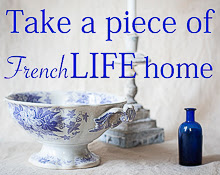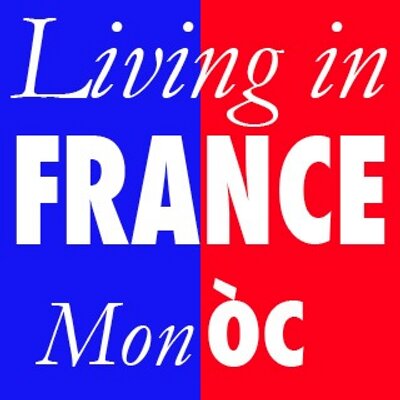Above: Two popular ways to find brocantes and vide greniers are signs like this one...and the website Brocabrac.fr.
Grant Innes has filled his beautiful old farmhouse in Maussane with antiques and brocante items found locally.
"I have a fetish for silver cutlery," Grant says. "I can spend hours on the hottest summer day, searching hundreds of stands for a dusty, tarnished old set of flatware, the one that, with a bit of spit and polish, will look like a million bucks. You can find wonderful brands like Ercuis, Christofle and Ravinet D'Enfert. They make lovely gifts too."
(Five photos) More of Grant's favorite finds. He paid 9€ each for his Napoleon and Josephine plates...and 50€ for the Champagne bucket. Lots of brocante loot is on display in his open living room, dining room and kitchen.
Blogger/brocante maven Corey Amaro found a "transition period" pair of armchairs in seafoam colored leather for 500€ at the brocante in Barjac, one of her favorites.
More of Corey's found treasures.
For her house in St. Remy, my friend Karen Pohlman is making a pillow from the old French postal sack she found at Emmaus. You can buy the pillow above here.
Antiquing is a both a national pastime and competitive sport in
France...and Provence is known to have some of the
finest antiquing in all the land. But it's also know to be expensive, unless you know where to go.
The great American tradition of the rummage sale, yard sale,
garage sale or estate sale doesn't exist here. (Actually, when I wanted to have
one in my driveway, I was told it's illegal. Yep, I did it anyway...and sold
nothing. But I had fun giving things away to passers-by!)
What does exist here is a wide range of other ways to buy old
things, from the very cheapest cr*p to the most-exquisite antiques.
Locals who love antiquing tend to follow the circuit...meaning they know which village to go to when...and where they're most likely to find things they love at fair prices. But for tourists--and those of us who love brocante but don't follow the scene closely--the code can be a bit tough to crack. And that's where the terrific website Brocabrac.fr comes in....and there's more info on that below.
First, here's some general info and popular places to get you started.
The village of Isle sur
la Sorgue is the epicenter...a major antiques center for all of
Europe. In addition to the items sold at the huge weekly Sunday morning market, there are as many as 250 antique shops and malls (with multiple
vendors) spread out around the village. Keep in mind that many shops and
stalls/malls are open on weekends only; others are Thursday through Sunday.
Then, there are second-hand shops such as the Depot
Vente in Eygalieres...and the
European chain known as Troc.
These shops tend to take old items on commission rather than buy them from owners outright.
While the selection is generally of lesser quality than what you'll find in the
shops of Isle sur la Sorgue, people have been known to happen on screaming good
deals. These shops can quickly feed your
addiction for second-hand treasures with a quick, cheap hit: dishes, small
pieces of furniture (side tables, etc.), lamps, art, linens, jewelry, books,
etc. You’ll also find huge pieces of wood furniture...not particularly beautiful but heavy, well made and inexpensive...and lots of not-so-pretty couches. Shops like these can be a good source for what’s known in the business as smalls; see what the New York Times says about smalls here.
Around France, you'll also see shops with Troc in the name that aren't part of this
national chain; some sell clothes only, others, a bit of everything. If you see "Troc" on the sign, it could be fun...so pop in.
Then there are charity shops such as Emmaus near Arles (on the D570, also known as the Route
Saintes Maries de la Mer, phone 04 90 49 79 76). Here people donate their old things and the
proceeds benefit a specific community, charity or cause. The equivalent in the US would be
Salvation Army or Goodwill. Again, you're not likely to find a precious
treasure...but it’s been known to happen. On the first Saturday of every
month at 9 am, this particular Emmaus (there are others around France) opens
the “special room” where they gather the best stuff all month. My friend Karen Pohlman went a few weeks ago and found a 7€ vintage linen La Poste mail bag, from which
she plans to make pillow for her St. Remy rental house. “It’s a pickers’ paradise,” she says, “but you
really need to dig.” (To see Karen's house, click here.)
Some weekly village markets, such as the Sunday one in Isle sur
la Sorgue, have old furniture, decorative items and housewares...in addition
to all the usual market items such as food, clothing, jewelry, linens and
more. The Wednesday market in St. Remy, for example, almost always has a couple
vendors selling small antique items such as tableware, artwork, pottery,
decorative items and small pieces of furniture.
Moving
on...most villages of any size have certain days of the year set aside for a
community brocante or vide grenier. (At a brocante you’ll find more antiques and more dealers selling, whereas a vide grenier--literally, “empty attic”--is more of a rummage sale with more individuals selling.) They're announced via signs (pasted
to trees and light poles, usually) and they happen in parks, parking lots and town
squares. Blogger Corey Amaro, a
passionate brocanter who features many of her finds in her online shop here, says
one of her favorites is the one in Barjac, which happens twice a year: the week before Easter and again
around the 15th of August. Corey used lots of her finds to decorate her own home in Provence, of course, but also her Paris rental apartment here.
Corey says she tends to have good luck at the smaller brocantes organized by Jean-Marie Dropsy, who does at least one brocante a month, with nearly 200 dealers. "I find most of my smalls there,” she reports. "I know for example that when I see Mr. Dropsy's name on Brocabrac, the fair will be good...he has dealers that follow him yearly." You can also find his brocantes listed on his blog or on Brocabrac.fr under the company name Utopies et Lumieres. Or, you an call email him (utopies-lumières@hotmail.fr) or call him: +33 (0)6 17 80 07 36.
Moving on...on certain days of the week, some villages have a weekly brocante, vide grenier or marché aux puces (flea market). The vide grenier on Wednesday morning in
Beaucaire comes to mind, held in a pretty, tree-shaded park by the Rhône River.
Three other examples are all day Sunday in Carpentras; Saturday and Sunday
mornings in Mornas (just off the A7 north of Orange) and every Sunday in
Jonquieres (in the Vaucluse).
A very nice brocante (known for high quality and good prices) is
every Saturday morning in Villeneuve lez Avignon, across the Rhône from Avignon.
Most markets and many brocantes and vide greniers finish up around
1 pm...but if sales are strong, the vendors stay on longer. Some go all day so
make sure to check.
The city of Arles has an all-day (8 am to
6 pm) Foire à la Brocante the
first Wednesday of every month. My friend Jill Mitchell reports: “The weekly Arles brocante is friendly with lots of charm, a good selection and good prices." The brocante is on the
Boulevard des Lices, the same grand street where the large Saturday morning
market is held. The Arles Tourist Office tells me to expect roughly 50 exhibitors at this brocante year round, with as
many as 60 in April and May.
Still another way to feed your antiquing fever is at one of the
large antique fairs or foires. Two
of the biggest ones in Europe are held each year in Isle sur la Sorgue: one
over Easter weekend (April 2 to 6, 2015) and one the weekend of August 15. There
you'll find hundreds of vendors selling all over town. You can try their
website here but it’s a
bit maddening as some of the info is two years old. The Isle sur la Sorgue
Tourist Office website here
should have complete info as the event draws closer.
Having never been to this particular Isle sur la Sorgue fair, I asked Jill Mitchell—who
leads antiquing trips in Provence and sells French vintage goods on Etsy and Ebay--what she thinks of it. "It's very good," she reports, "offering an amped up version of the regular Sunday market, with vendors
often coming from around Europe. My two cents though, is that on any
Sunday of the year, Isle sur la Sorgue is already so abundant with fantastic
items (nearly to the point of overwhelm) that it's a great destination either
way. In general, however, prices in L'Isle are much higher than
you'll find in other city and village markets in Provence. The rule is,
using the price for an item bought in Marseille as a base, add 35% for the same
item for the Isle sur la Sorgue price and add another 35% to that for the Paris
price."
And yet another big foire (also known as a déballage, which means unpacking) happens in an Avignon expo park seven
times a year--roughly every six weeks--but you need to have professional credentials
to get in (the info is here).
A friend who’s been reports: “It’s a wonderful collection of some very fine
antiques. Mostly dealers buying for their shops. Good prices and
some room for negotiation. Things sell very fast so you need to make
quick decisions. Mostly indoors in
multiple buildings and some on lots outside.” Beziers and Montpellier have
similar déballages.
Of course you’ll find examples of all
the above all throughout France, not just here in the South. The annual Grande Braderie of Lille (in northern France), for example, is a
mega-brocante, with a reported 200 km (125 miles) of stalls. I’m told it dates to the 12th
century and attracts as many as 10,000 sellers. It takes place the first weekend in September. Let’s go!
Ok so what about Brocabrac.fr? I learned about it just last week at dinner at the vacation home of my friend Grant Innes. I was admiring all his wonderful antiques and objets...and he told me that most came from local antique shops, brocantes and vide greniers. Grant's been collecting for years and uses Brocabrac religiously to plan his forays. He says his favorite find ever was the pair of blue and white Delft-style plates pictured above--one with image of Napoléon, the other, Josephine--that now hang on the wall in his dining room. The plates were 9€ each, at a vide grenier in Carpentras. His more-recent purchases include the elegant seau à Champagne also pictured above, from a pop-up brocante in Sénas for 50€, and a set of nine Salvador Dali plates for 10€.
Grant likes to plan ahead, checking the Brocobrac site the day before he heads out. “Then I get on the road early with my dog, Luca,” he reports, “and we make a day of it, visiting up to five or six different towns. It’s a lovely way to explore Provence.”
The Brocabrac site is only in French but it's easy to figure out. Just find your region on the map, click it...and wait for the list to appear on the right. What's great is the site shows you what's happening today, this week...and for quite a few weeks to come.
For brocante beginners, Grant's best advice is: dress down, carry coins and small bills, try to haggle if that’s your thing, always start any inquiry with “bonjour Monsieur or Madame”...and above all, be polite and respectful. He also suggests you have a couple sturdy shopping bags in your trunk, plus newspaper and bubble wrap, “because you may find the perfect set of Baccarat wine goblets but not in the original packaging.” Bring water in summer, he adds, because brocantes and vide greniers are often held in open parking lots or sports fields, in direct sun.
So that's the general lay of the land. Obviously, you're not going to find the same things at a flea market in a dusty field as you will at a high-end antiques show...but both are fun and could be fruitful! So have at it...good luck...and
let me know what you find! And if you have a favorite shop or regular brocante you
care to share, please leave it as a comment below.






























































.jpg)





















This is a really interesting post. In England, we go to car boot sales as a national hobby and the bargains are much better than in France. My tip is to go to the smaller places. I've found great opportunities in St Andiol ,St Restuit (hand sewn Vietnamese pictures) and Upie (ancient photos comprising social history for 1 euro). Carpentras on a Sunday is a great shout. Having said that, last year I bought original Tintin annuals at a good price in St Remy. If you're an ex-pat or visitor, you have to look for the things that the French don't think anyone in their right mind would want.
ReplyDeleteHow the heck do you work as hard as you do and still manage to always put out great info with great photos!!????
ReplyDeleteYou are amazing Woman!
Julie, How the heck do you work as hard as you do and still manage to put out great info with great photos!!????
ReplyDeleteYou are amazing Woman!
What a great comprehensive post, Julie! Gee, my mouth is watering just reading it. Can't wait to get to my next brocante. : ) Thanks for the links to my shops.
ReplyDeleteBises!
Great info. Many thanks for the tips.
ReplyDelete